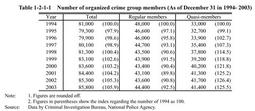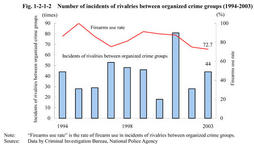| Previous Next Index Image Index Year Selection | |
|
|
1. Trends in organized crime groups Table 1-2-1-1 shows the number of regular members and quasi-members of organized crime groups(both hereinafter referred to as"organized crime group members"in this section)as of December31of each year since1994.In2003regular members increased by about800persons whereas quasi-members decreased by about300persons over2002.
Table 1-2-1-1 Number of organized crime group members(As of December31in1994-2003) As of December31,2003,24organized crime groups were designated as designated organized crime groups under the Law to Prevent Unjust Acts by Organized Crime Group Members (Law No.77of1991;hereinafter referred to as"Anti-Organized Crime Group Law"in this section).Regular members of the three major groups,the Fifth Yamaguchi-Gumi,the Inagawa-Kai,and the Sumiyoshi-Kai,were around32,000(up around800from the previous year),accounting for72.1%of the total regular members of organized crime groups.Under the Anti-Organized Crime Group Law,2,609 stop orders and114 recurrence preventive orders were issued in2003,an increase of10and decrease of27from2002respectively(Source:Data by Criminal Investigation Bureau,National Police Agency).Fig. 1-2-1-2 shows the number of incidents of rivalries between organized crime groups and the firearms use rate(cases of firearm use tin those rivalries)over the last10years.In2003,rivalries between organized crime groups increased by16from2002.Under the Law for Partial Amendment of the Anti-Organized Crime Group Law(Law No.38of2004)put into force in April2004,the representative of a designated organized crime group shall be liable to pay compensation for damage arising from an injury to the life,body or property of another caused by any of its members in an incident of rivalry with the use of a weapon. Fig. 1-2-1-2 Number of incidents of rivalries between organized crime groups(1994-2003) |

